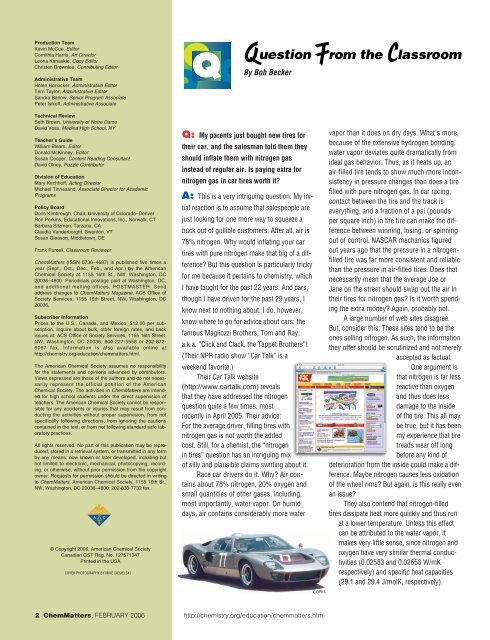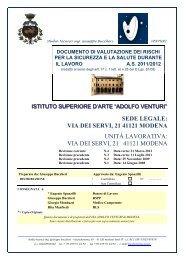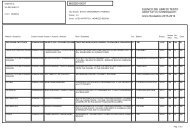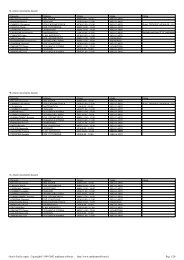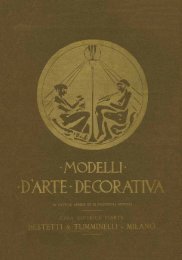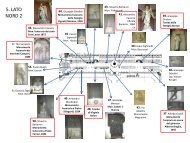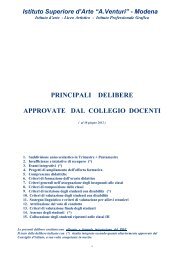and Printing
Super Fibers - A. Venturi
Super Fibers - A. Venturi
- No tags were found...
Create successful ePaper yourself
Turn your PDF publications into a flip-book with our unique Google optimized e-Paper software.
Production TeamKevin McCue, EditorCornithia Harris, Art DirectorLeona Kanaskie, Copy EditorChristen Brownlee, Contributing EditorAdministrative TeamHelen Herlocker, Administrative EditorTerri Taylor, Administrative EditorS<strong>and</strong>ra Barlow, Senior Program AssociatePeter Isikoff, Administrative AssociateTechnical ReviewSeth Brown, University of Notre DameDavid Voss, Medina High School, NYTeacher’s GuideWilliam Bleam, EditorDonald McKinney, EditorSusan Cooper, Content Reading ConsultantDavid Olney, Puzzle ContributorDivision of EducationMary Kirchhoff, Acting DirectorMichael Tinnes<strong>and</strong>, Associate Director for AcademicProgramsPolicy BoardDoris Kimbrough, Chair, University of Colorado–DenverRon Perkins, Educational Innovations, Inc., Norwalk, CTBarbara Sitzman, Tarzana, CAClaudia V<strong>and</strong>erborght, Swanton, VTSusan Gleason, Middletown, DEFrank Purcell, Classroom ReviewerChemMatters (ISSN 0736–4687) is published five times ayear (Sept., Oct., Dec., Feb., <strong>and</strong> Apr.) by the AmericanChemical Society at 1155 16th St., NW, Washington, DC20036–4800. Periodicals postage paid at Washington, DC,<strong>and</strong> additional mailing offices. POSTMASTER: Sendaddress changes to ChemMatters Magazine, ACS Office ofSociety Services, 1155 16th Street, NW, Washington, DC20036.Subscriber InformationPrices to the U.S., Canada, <strong>and</strong> Mexico: $12.00 per subscription.Inquire about bulk, other foreign rates, <strong>and</strong> backissues at: ACS Office of Society Services, 1155 16th Street,NW, Washington, DC 20036; 800-227-5558 or 202-872-6067 fax. Information is also available online athttp://chemistry.org/education/chemmatters.html.The American Chemical Society assumes no responsibilityfor the statements <strong>and</strong> opinions advanced by contributors.Views expressed are those of the authors <strong>and</strong> do not necessarilyrepresent the official position of the AmericanChemical Society. The activities in ChemMatters are intendedfor high school students under the direct supervision ofteachers. The American Chemical Society cannot be responsiblefor any accidents or injuries that may result from conductingthe activities without proper supervision, from notspecifically following directions, from ignoring the cautionscontained in the text, or from not following st<strong>and</strong>ard safe laboratorypractices.All rights reserved. No part of this publication may be reproduced,stored in a retrieval system, or transmitted in any formby any means, now known or later developed, including butnot limited to electronic, mechanical, photocopying, recording,or otherwise, without prior permission from the copyrightowner. Requests for permission should be directed in writingto ChemMatters, American Chemical Society, 1155 16th St.,NW, Washington, DC 20036–4800; 202-833-7732 fax.© Copyright 2006, American Chemical SocietyCanadian GST Reg. No. 127571347Printed in the USACOVER PHOTOGRAPHY BY MIKE CIESIELSKIQ: My parents just bought new tires fortheir car, <strong>and</strong> the salesman told them theyshould inflate them with nitrogen gasinstead of regular air. Is paying extra fornitrogen gas in car tires worth it?A: This is a very intriguing question. My initialreaction is to assume that salespeople arejust looking for one more way to squeeze abuck out of gullible customers. After all, air is78% nitrogen. Why would inflating your cartires with pure nitrogen make that big of a difference?But this question is particularly trickyfor me because it pertains to chemistry, whichI have taught for the past 22 years. And cars,though I have driven for the past 29 years, Iknow next to nothing about. I do, however,know where to go for advice about cars: thefamous Magliozzi Brothers, Tom <strong>and</strong> Ray,a.k.a. “Click <strong>and</strong> Clack, the Tappet Brothers”!(Their NPR radio show “Car Talk” is aQ uestion F rom the C lassroomBy Bob Beckerweekend favorite.)Their Car Talk website(http://www.cartalk.com) revealsthat they have addressed the nitrogenquestion quite a few times, mostrecently in April 2005. Their advice:For the average driver, filling tires withnitrogen gas is not worth the addedcost. Still, for a chemist, the “nitrogenin tires” question has an intriguing mixof silly <strong>and</strong> plausible claims swirling about it.Race car drivers do it. Why? Air containsabout 78% nitrogen, 20% oxygen <strong>and</strong>small quantities of other gases, including,most importantly, water vapor. On humiddays, air contains considerably more waterCORELvapor than it does on dry days. What's more,because of the extensive hydrogen bonding,water vapor deviates quite dramatically fromideal gas behavior. Thus, as it heats up, anair-filled tire tends to show much more inconsistencyin pressure changes than does a tirefilled with pure nitrogen gas. In car racing,contact between the tire <strong>and</strong> the track iseverything, <strong>and</strong> a fraction of a psi (poundsper square inch) in the tire can make the differencebetween winning, losing, or spinningout of control. NASCAR mechanics figuredout years ago that the pressure in a nitrogenfilledtire was far more consistent <strong>and</strong> reliablethan the pressure in air-filled tires. Does thatnecessarily mean that the average Joe orJane on the street should swap out the air intheir tires for nitrogen gas? Is it worth spendingthe extra money? Again, probably not.A large number of web sites disagree.But, consider this: These sites tend to be theones selling nitrogen. As such, the informationthey offer should be scrutinized <strong>and</strong> not merelyaccepted as factual.One argument isthat nitrogen is far lessreactive than oxygen<strong>and</strong> thus does lessdamage to the insideof the tire. This all maybe true, but it has beenmy experience that tiretreads wear off longbefore any kind ofdeterioration from the inside could make a difference.Maybe nitrogen causes less oxidationof the wheel rims? But again, is this really evenan issue?They also contend that nitrogen-filledtires dissipate heat more quickly <strong>and</strong> thus runat a lower temperature. Unless this effectcan be attributed to the water vapor, itmakes very little sense, since nitrogen <strong>and</strong>oxygen have very similar thermal conductivities(0.02583 <strong>and</strong> 0.02658 W/mKrespectively) <strong>and</strong> specific heat capacities(29.1 <strong>and</strong> 29.4 J/molK, respectively).2 ChemMatters, FEBRUARY 2006http://chemistry.org/education/chemmatters.html


